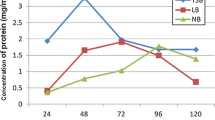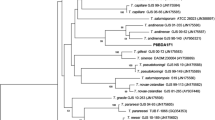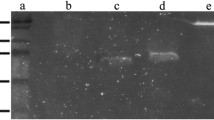Abstract
Xenorhabdus and Photorhabdus spp. are enteric bacterial symbionts of Steinernema and Heterorhabditis nematodes, respectively. These bacteria produce an extensive set of natural products (NPs) with antibacterial, antifungal, antiprotozoal, insecticidal, or other bioactivities when vectored into insect hemocoel by nematodes. We assessed the in vitro activity of different Xenorhabdus and Photorhabdus cell-free supernatants against important fungal phytopathogens, viz., Cryphonectria parasitica, Fusarium oxysporum, Rhizoctonia solani, and Sclerotinia sclerotiorum and identified the bioactive antifungal compound/s present in the most effective bacterial supernatant using the easyPACId (easy promoter–activated compound identification) approach against chestnut blight C. parasitica. Our data showed that supernatants from Xenorhabdus species were comparatively more effective than extracts from Photorhabdus in suppressing the fungal pathogens; among the bacteria assessed, Xenorhabdus szentirmaii was the most effective species against all tested phytopathogens especially against C. parasitica. Subsequent analysis revealed fabclavines as antifungal bioactive compounds in X. szentirmaii, generated by a polyketide synthase (PKS) and non-ribosomal peptide synthetase (NRPS) hybrid system. Fabclavines are broad-spectrum, heat-stable NPs that have great potential as biological control compounds against fungal plant pathogens. More studies are needed to assess the potential phytotoxicity of these compounds and their effects on non-target organisms before commercialization.
Key points
• Chemical fungicides have toxic effects on humans and other non-target organisms.
• Alternatives with novel modes of action to supplant current fungicide are needed.
• A novel bioactive antifungal compound from Xenorhabdus szentirmaii was identified.
Graphical abstract








Similar content being viewed by others
Data availability
All the data generated from this study are included in this article.
References
Akhurst RJ (1980) Morphological and functional dimorphism in Xenorhabditis spp., bacteria symbiotically associated with the insect pathogenic nematodes Neoaplectana and Heterorhabditis. J Gen Microbiol 121:303–309
Almeida F, Rodrigues ML, Coelho C (2019) The still underestimated problem of fungal diseases worldwide. Front Microbiol 10:214
Bock CH, Shapiro-Ilan DI, Wedge D, Cantrell CH (2014) Identification of the antifungal compound, trans cinnamic acid, produced by Photorhabdus luminescens, a potential biopesticide. J Pest Sci 87:155–162
Bode HB (2009) Entomopathogenic bacteria as a source of secondary metabolites. Curr Opin Chem Biol 13:1–7
Bode E, Brachmann AO, Kegler C, Şimşek R, Dauth C, Zhou Q, Kaiser M, Klemmt P, Bode HB (2015) Simple “on-demand” production of bioactive natural products. ChemBioChem 16:1115–1119
Bode E, Heinrich AK, Hirschmann M, Abebew D, Shi YN, Vo TD, Wesche F, Shi YM, Grün P, Simonyi S, Keller N, Engel Y, Wenski S, Bennet R, Beyer S, Bischoff I, Buaya A, Brandt S, Cakmak I, Cimen H, Eckstein S, Frank D, Fürst R, Gand M, Geisslinger G, Hazir S, Henke M, Heermann R, Lecaudey V, Schäfer W, Schiffmann S, Schüffler A, Schwenk R, Skaljac M, Thines E, Thines M, Ulshöfer T, Vilcinskas A, Wichelhaus TA, Bode HB (2019) Promoter activation in Δhfq mutants as an efficient tool for specialized metabolite production enabling direct bioactivity testing. Angew Chem Int Ed 131:19133–19139
Boemare N, Akhurst RJ (2006) The genera Photorhabdus and Xenorhabdus. In: Dworkin M, Falkow S, Rosenberg E, Schleifer KH, Stackebrandt E (eds) The prokaryotes. Springer Science + Business Media Inc, New York, pp 451–494
Boszormenyi E, Ersek T, Fodor A, Fodor AM, LSz F, Hevesi M, Hogan JS, Katona Z, Klein MG, Kormany A, Pekar S, Szentirmai A, Sztaricskai F, RAJ T (2009) Isolation and activity of Xenorhabdus antimicrobial compounds against the plant pathogens Erwinia amylovora and Phytophthora nicotianae. J Appl Microbiol 107:746–759
Burger J, Mol F, Gerowitt B (2008) The ‘necessary extent’ of pesticide use—Thoughts about a key term in German pesticide policy. Crop Prot 27:343–351
Chacón Orozco JG, CJr B, Shapiro Ilan DI, Hazir S, Leite LG, Harakava R (2020) Antifungal activity of Xenorhabdus spp. and Photorhabdus spp. against the soybean pathogenic Sclerotinia sclerotiorum. Sci Rep 10:20649
Clarke DJ (2008) Photorhabdus: a model for the analysis of pathogenicity and mutualism. Cell Microbiol 10:2159–2167
Donmez Ozkan H, Cimen H, Ulug D, Wenski S, Yigit Ozer S, Telli M, Aydin N, Bode HB, Hazir S (2019) Nematode-associated bacteria: Production of antimicrobial agent as a presumptive nominee for curing endodontic infections caused by Enterococcus faecalis. Front Microbiol 10:2672
Dreyer J, Malan AP, Dicks LMT (2018) Bacteria of the genus Xenorhabdus, a novel source of bioactive compounds. Front Microbiol 9:1–14
Erincik O, Doken MT, Acikgoz S, Ertan E (2008) Characterization of Cryphonectria parasitica isolates collected from Aydın province in Turkey. Phytoparasitica 36(3):249–259
Fang XL, Li ZZ, Wang YH, Zhang X (2011) In vitro and in vivo antimicrobial activity of Xenorhabdus bovienii YL002 against Phytophthora capsici and Botrytis cinerea. J Appl Microbiol 111(1):145–154
FAO (2018) The future of food and agriculture – alternative pathways to 2050. Food and Agriculture Organization, Rome, p 224
Fisher MC, Hawkins NJ, Sanglard D, Gurr SJ (2018) Worldwide emergence of resistance to antifungal drugs challenges human health and food security. Science 360:739–742
Fodor A, Fodor AM, Forst S, Hogan JS, Klein MG, Lengyel K, Saringer G, Stackebrandt E, Taylor RAJ, Lehoczky E (2010) Comparative analysis of antibacterial activities of Xenorhabdus species on related and nonrelated bacteria in vivo. J Microbiol Antimicrob 2:36–46
Fodor A, Makrai L, Fodor L, Venekei I, Husveth F, Pal L, Molnar A, Dublecz K, Pinter C, Jozsa S, Klein MG (2017) Anti-coccidiosis potential of autoclaveable antimicrobial peptides from Xenorhabdus budapestensis resistant to proteolytic (pepsin, trypsin) digestion based on in vitro studies. Microbiol Res J Int 22:1–17
Forst S, Clarke D (2002) Bacteria-nematode symbiosis. In: Gaugler R (ed) Entomopathogenic nematology. CABI, New York, pp 57–77
Forst S, Dowds B, Boemare N, Stackebrandt E (1997) Xenorhabdus and Photorhabdus spp.: bugs that kill bugs. Annu Rev Microbiol 51:47–72
Fravel D, Olivain C, Alabouvette C (2003) Fusarium oxysporum and its biocontrol. New Phytol 157(3):493–502
Fuchs SW, Grundmann F, Kurz M, Kaiser M, Bode HB (2014) Fabclavines: bioactive peptide-polyketide-polyamino hybrids from Xenorhabdus. ChemBioChem 15(4):512–516
Furgani G, Boszormenyi E, Fodor A, Fodor AM, Forst S, Hogan J, Katona Z, Klein MG, Stackebrandt E, Szentirmai A, Sztaricskai F, Wolf S (2008) Xenorhabdus antibiotics: a comparative analysis and potential utility for controlling mastitis caused by bacteria. J Appl Microbiol 104:745–758
Givaudan A, Baghdiguian S, Lanois A, Boemare N (1995) Swarming and swimming changes concomitant with phase variation in Xenorhabdus nematophilus. Appl Environ Microbiol 61:1408–1413
González M, Pujol M, Metraux J, González-Garcia V, Bolton MD, Borrás-Hidalgo O (2011) Tobacco leaf spot and root rot caused by Rhizoctonia solani Kühn. Mol Plant Pathol 12:209–216
Gulcu B, Cimen H, Raja KR, Hazir S (2017) Entomopathogenic nematodes and their mutualistic bacteria: Their ecology and application as microbial control agents. Biopestic Int 13:79–112
Hazir S, Shapiro-Ilan DI, Bock CH, Hazir C, Leite LG, Hotchkiss MW (2016) Relative potency of culture supernatants of Xenorhabdus and Photorhabdus spp. on growth of some fungal phytopathogens. Eur J Plant Pathol 146:369–381
Hazir S, Shapiro-Ilan DI, Bock CH, Leite LG (2017) trans-Cinnamic acid and Xenorhabdus szentirmaii metabolites synergize the potency of some commercial fungicides. J Invertebr Pathol 145:1–8
Houard J, Aumelas A, Noel T, Pages S, Givaudan A, Fitton- Ouhabi V, Villain-Guillot P, Gualtieri M (2013) Cabanillasin, a new antifungal metabolite, produced by entomopathogenic Xenorhabdus cabanillasii JM26. J Antibiot 66:617–620
Jallouli W, Abdelkefi M, Tounsi S, Jaoua S, Zouari N (2013) Potential of Photorhabdus temperata K122 bioinsecticide in protecting wheat flour against Ephestia kuehniella. J Stored Prod 53:61–66
Le Cointe R, Simon TE, Delarue P, Herve M, Leclerc M, Poggi S (2016) Reducing the use of pesticides with site specific application: The chemical control of Rhizoctonia solani as a case of study for the management of soil-borne diseases. PLoS One 11(9):e0163221
Machado RAR, Bruno P, Arce CCM, Liechti N, Köhler A, Bernal J, Bruggmann R, Turlings TCJ (2019) Photorhabdus khanii subsp. guanajuatensis subsp. nov., isolated from Heterorhabditis atacamensis, and Photorhabdus luminescens subsp. mexicana subsp. nov., isolated from Heterorhabditis mexicana entomopathogenic nematodes. Int J Syst Evol Microbiol 69(3):652–661
Martins P, Merfa MV, Takita MA, De Souza AA (2018) Persistence in phytopathogenic bacteria: Do we know enough? Front Microbiol 9:1099
Masschelein J, Mattheus W, Gao LJ, Moons P, Van Houdt R, Uytterhoeven B, Lamberigts C, Lescrinier E, Rozenski J, Herdewijn P, Aertsen A, Michiels C, Lavigne R (2013) A PKS/NRPS/FAS hybrid gene cluster from Serratia plymuthica RVH1 encoding the biosynthesis of three broad spectrum, zeamine-related antibiotics. PLoS One 8:e54143
Masschelein J, Clauwers C, Stalmans K, Nuyts K, De Borggraeve W, Briers Y, Aertsen A, Michiels CW, Lavigne R (2015) The zeamine antibiotics affect the integrity of bacterial membranes. Appl Environ Microbiol 81(3):1139–1146
Michielse CB, Rep M (2009) Pathogen profile update: Fusarium oxysporum. Mol Plant Pathol 10(3):311–324
Rao PV, Gan SH (2014) Cinnamon: a multifaceted medicinal plant. Evid Based Complementary Altern Med 2014:642942
Rigling D, Prospero S (2018) Cryphonectria parasitica, the causal agent of chestnut blight: invasion history, population biology and disease control. Mol Plant Pathol 19(1):7–20
Saharan GS, Mehta N (2008) Sclerotinia diseases of crop plants: biology, ecology and disease management. Springer Science Busines Media BV, The Netherlands
Sajnaga E, Kazimierczak W (2020) Evolution and taxonomy of nematode-associated entomopathogenic bacteria of the genera Xenorhabdus and Photorhabdus: an overview. Symbiosis 80:1–13
San-Blas E, Carrillo Z, Parra Y (2012) Effect of Xenorhabdus and Photorhabdus bacteria and their exudates on Moniliophthora roreri. Arch Phytopathol Plant Protect 45:1950–1967
San-Blas E, Parra Y, Carrillo Z (2013) Effect of Xenorhabdus and Photorhabdus bacteria (Enterobacteriales: Enterobacteriaceae) and their exudates on the apical rotten fruit disease caused by Dothiorella sp. in guava (Psidium guajava). Arch Phytopathol Plant Protect 46:2294–2303
Savary S, Teng PS, Willocquet L, Nutter FW Jr (2006) Quantification and modeling of crop losses: a review of purposes. Annu Rev Phytopathol 44:89–112
Shapiro-Ilan DI, Reilly CC, Hotchkiss MW (2009) Suppressive effects of metabolites from Photorhabdus and Xenorhabdus spp. on phytopathogens of peach and pecan. Arch Phytopathol Plant Protect 42:715–728
Shapiro-Ilan DI, Bock CH, Hotchkiss MW (2014) Suppression of pecan and peach pathogens on different substrates using Xenorhabdus bovienii and Photorhabdus luminescens. Biol Control 77:1–6
Shapiro-Ilan DI, Arthurs SP, Lacey LA (2017) Microbial control of arthropod pests of orchards in temperate climates. In: Lacey LA (ed) Microbial control of insect and mite pests. Elsevier, Amsterdam, pp 253–267
Shi D, An R, Zhang W, Zhang G, Yu Z (2017) Stilbene derivatives from Photorhabdus temperata SN259 and their antifungal activities against phytopathogenic fungi. J Agric Food Chem 65:60–65
Smolińska U, Kowalska B (2018) Biological control of the soil-borne fungal pathogen Sclerotinia sclerotiorum – a review. J Plant Pathol 100:1–12
Strange RN, Scott PR (2005) Plant disease: a threat to global food security. Annu Rev Phytopathol 43(1):83–116
Szallas E, Koch G, Fodor A, Burghardt J, Buss O, Szentirmai A, Nealson KH, Stackebrandt E (1997) Phylogenetic evidence for the taxonomic heterogeneity of Photorhabdus luminescens. Int J Syst Bacteriol 47:402–407
Szallas E, Pukall R, Pamjav H, Kovacs G, Buzas Z, Fodor A, Stackebrandt E (2001) Passengers who missed the train: comparative sequence analysis, PhastSystem PAGEPCR-RFLP and automated RiboPrint phenotypes of Photorhabdus strains. In: Griffin CT, Burnell AM, Downes MJ, Mulder R (eds) Developments in entomopathogenic nematode/bacterial research. European Commission Publications, Luxemburg, pp 36–53
Talbot NJ (2010) Living the sweet life: How does a plant pathogenic fungus acquire sugar from plants? PLoS Biol 8(2):e1000308
Tobias NJ, Wolff H, Djahanschiri B, Grundmann F, Kronenwerth M, Shi YM, Simonyi S, Grün P, Shapiro-Ilan DI, Pidot SJ, Stinear TP, Ebersberger I, Bode HB (2017a) Natural product diversity associated with the nematode symbionts Photorhabdus and Xenorhabdus. Nat Microbiol 2(12):1676–1685
Tobias NJ, Heinrich AK, Eresmann H, Wright PR, Neubacher N, Backofen R (2017b) Photorhabdus-nematode symbiosis is dependent on hfq-mediated regulation of secondary metabolites. Environ Microbiol 19:119–129
Ullah I, Khan AL, Ali L, Khan AR, Waqas M, Hussain J, Lee IJ, Shin JH (2015) Benzaldehyde as an insecticidal, antimicrobial, and antioxidant compound produced by Photorhabdus temperata M1021. J Microbiol 53(2):127–133
Webster JM, Chen G, Hu K, Li J (2002) Bacterial metabolites. In: Gaugler R (ed) Entomopathogenic nematology. CABI International, London, pp 99–114
Wenski SL, Kolbert D, Grammbitter GLC, Bode HB (2019) Fabclavine biosynthesis in X. szentirmaii: shortened derivatives and characterization of the thioester reductase FclG and the condensation domain-like protein FclL. J Ind Microbiol Biotechnol 46(3-4):565–572
Wenski SL, Cimen H, Berghaus N, Fuchs SW, Hazir S, Bode HB (2020) Fabclavine diversity in Xenorhabdus bacteria. Beilstein J Org Chem 16:956–965
Zubrod JP, Bundschuh M, Arts G, Brühl CA, Imfeld G, Knäbel A, Payraudeau S, Rasmussen JJ, Rohr J, Scharmüller A, Smalling K, Stehle S, Schulz R, Schäfer RB (2019) Fungicides: an overlooked pesticide class? Environ Sci Technol 53(7):3347–3365
Funding
The study was supported by Aydin Adnan Menderes University Research Fund, Turkey (Project number: FEF-16003). Work in the Bode lab was supported in part by the LOEWE center TBG and the LOEWE research cluster MegaSyn.
Author information
Authors and Affiliations
Contributions
HC, SH, and DS designed the research. HC carried out the research. HB and SW generated promoter exchanged mutant strains. MT, SHG, and OE assisted with the experiments. HC, SH, and DS wrote the manuscript.
Corresponding author
Ethics declarations
Ethics approval
This article does not contain any studies with human participants or animals performed by any of the authors.
Conflict of interest
The authors declare no competing interests.
Additional information
Publisher’s note
Springer Nature remains neutral with regard to jurisdictional claims in published maps and institutional affiliations.
Rights and permissions
About this article
Cite this article
Cimen, H., Touray, M., Gulsen, S.H. et al. Antifungal activity of different Xenorhabdus and Photorhabdus species against various fungal phytopathogens and identification of the antifungal compounds from X. szentirmaii. Appl Microbiol Biotechnol 105, 5517–5528 (2021). https://doi.org/10.1007/s00253-021-11435-3
Received:
Revised:
Accepted:
Published:
Issue Date:
DOI: https://doi.org/10.1007/s00253-021-11435-3




